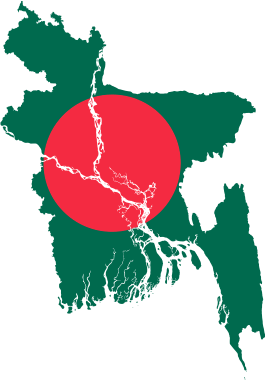1947 Sylhet referendum
The Sylhet referendum was a referendum held in Sylhet to decide whether Sylhet would remain in Assam and join the new country of India or would join the province of East Bengal and the new country of Pakistan. The referendum decided in favor of joining Pakistan;[1] however, Karimganj remained in India.
| Sylhet referendum | |||||||||||||||||||
|---|---|---|---|---|---|---|---|---|---|---|---|---|---|---|---|---|---|---|---|
| Should Sylhet join the province of East Bengal in Pakistan? | |||||||||||||||||||
| Location | Sylhet, Assam Province, British Raj | ||||||||||||||||||
| Date | 6 July 1947 | ||||||||||||||||||
| |||||||||||||||||||
Part of a series on the |
|---|
| History of Bangladesh |
 |
|
|
Ancient
|
|
Classical
|
|
Medieval
|
|
Modern
|
|
Contemporary
|
|
Related articles |
|
|
History
Originally, the Greater Sylhet region, erstwhile Sylhet Sarkar, was part of the Bengal Subah of the Mughal Empire until it came under British administration in 1765. Initially, the region became part of the Bengal Presidency. Despite protests to the Viceroy from its Bengali-majority population, on 16 February 1874 the region became part of the non-regulation Chief Commissioner's Province of Assam (North-East Frontier Province) in order to facilitate Assam's commercial development.[2] After the first partition of Bengal in 1905 it became re-incorporated into Eastern Bengal and Assam. Sylhet became separated from Bengal again in 1912 when Assam was reconstituted into a chief commissioners' province.[3]
Background

The partition of India was to happen along religious lines. The Muslim-majority areas would form Pakistan while the Hindu-majority areas would form India.[4] Sylhet was a Muslim-majority Bengali-speaking district in Assam which was a Hindu-majority Assamese-speaking province. The Government of Assam believed removing Sylhet would make the state more homogeneous and stronger as a result. Assam's Prime Minister Gopinath Bordoloi said in 1946 that his wish was to "hand over Sylhet to East Bengal".[5] The Government of British Raj declared on 3 July 1947 that a referendum would be held to decide the future of Sylhet on 7 July 1947. H. C. Stock was appointed the commissioner of the referendum.[1]
Result
The majority of the population voted in favour of joining Pakistan. It was implemented in the Article 3 of the India Independence Act of 18 July 1947. The Radcliffe line published on 12 August 1947 gave some areas of Sylhet mainly the Karimganj, to India, while the rest of Sylhet joined East Bengal. Even though there was a majority vote across Sylhet to join East Bengal, the published Radcliffe line gave some areas of Sylhet to India like Karimganj, while the rest of Sylhet joined East Pakistan. It had a majority Muslim population which had opted for Pakistan unlike some other areas in Sylhet like Moulvibazar which had not.[1][6] India received three and a half thanas from Sylhet.[7][8] However, the result of the referendum was welcomed in Assam.[9] Thus, most of the Sylhet district of British Indian province of Assam joined East Pakistan, which subsequently became independent Bangladesh in 1971.[10]
References
- Chowdhury, Dewan Nurul Anwar Husain. "Sylhet Referendum, 1947". en.banglapedia.org. Banglapedia. Retrieved 20 November 2016.
- Tanweer Fazal (2013). Minority Nationalisms in South Asia. Routledge. pp. 53–54. ISBN 978-1-317-96647-0.
- William Cooke Taylor, A Popular History of British India. p. 505
- "History - British History in depth: The Hidden Story of Partition and its Legacies". bbc.co.uk. BBC. Retrieved 20 November 2016.
- Daniyal, Shoaib. "With Brexit a reality, a look back at six Indian referendums (and one that never happened)". Scroll.in. Scroll. Retrieved 20 November 2016.
- https://muradqureshi.com/sylhets-own-brexit-partition-referendum-of-1947/
- "Recovering Sylhet". Himal Southasian. 22 November 2012. Retrieved 20 November 2016.
- "Assam Election Results - What does it mean for Bangladesh?". The Daily Star. 21 May 2016. Retrieved 20 November 2016.
- Fazal, Tanweer (18 October 2013). Minority Nationalisms in South Asia. Routledge. p. 56. ISBN 978-1-317-96647-0.
- LaPorte, R (1972). "Pakistan in 1971: The Disintegration of a Nation". Asian Survey. 12 (2): 97–108. doi:10.1525/as.1972.12.2.01p0190a.